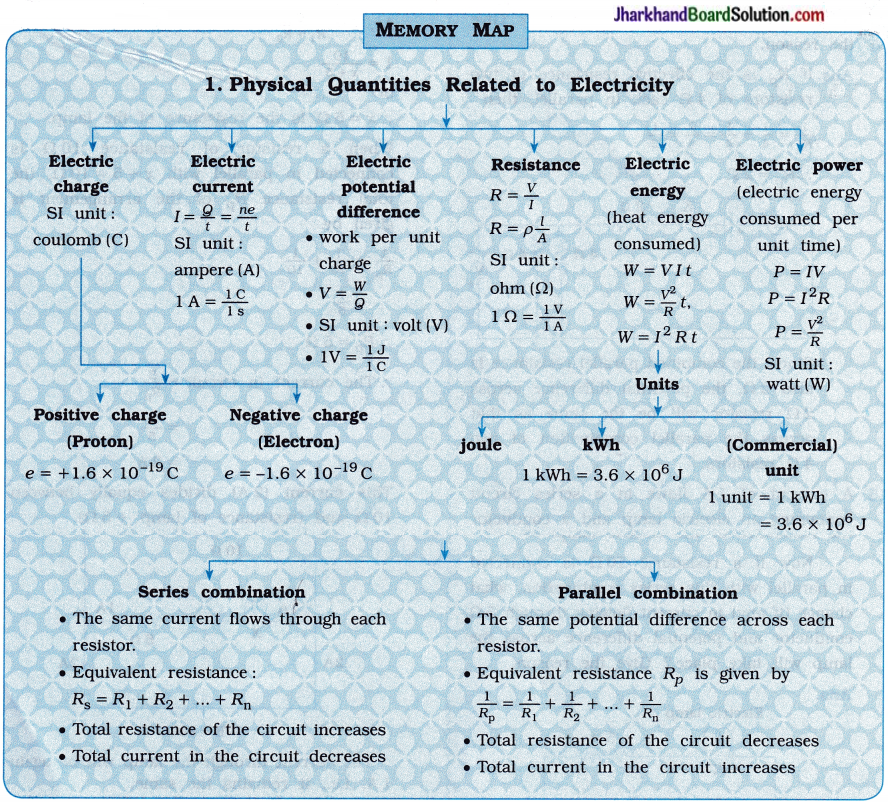Jharkhand Board JAC Class 10 Science Important Questions Chapter 12 Electricity Important Questions and Answers.
JAC Board Class 10 Science Important Questions Chapter 12 Electricity
Additional Questions and Answers
Question 1.
Solve the following examples :
1. 240 joules of work Is done in moving 20 coulomb electric charge from one pole to the other pole of a battery. Calculate the voltage of the battery.
Answer:
12 V
2. 5 V electric potential difference is applied between two ends of a conducting wire. If 600 C of electric charge passes through it in 10minutes, calculate the resistance of the wire.
Answer:
5 Ω
3. TWo copper wires A and B have the same mass. The resistance of wire A is 0.5 Ω and the length of wire B is double that of wire
A. Find the resistance of wire B.
Answer:
2 Ω
4. If the length of a given conducting wire is kept constant and its diameter is doubled, what will be the resistance of the new wire?
Answer:
\(\frac { R }{ 4 }\)
5. Two resistors of 1 kΩ and 200Ω are connected in series with a 12 V battery. Calculate the current flowing in the circuit and the voltage developed across the 200 Ω resistor.
Answer:
I = 0.01 A, V = 2 V
6. For the circuit shown in figure given below, calculate
(a) the total resistance of the circuit.
(b) the total current flowing in the circuit.
(c) the voltage developed across the two ends of R1.
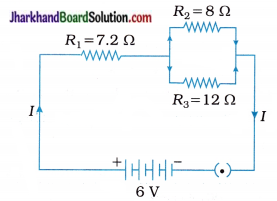
Answer:
(a) 12 Ω
(b) 0.5 A
(c) 3.6 V
7. Two 60W bulbs are used for 4hours every day and five 100W bulbs are used for 5 hours everyday. How many units of electricity will be consumed in 30 days?
Answer:
89.4 units
![]()
8. 24 W power is consumed by a bulb when it is connected with 12 V battery. How much power will be consumed if it is connected with 6V battery?
Answer:
6 W
9. Find the equivalent resistance of the circuit shown in the following figure :
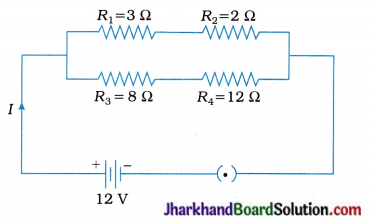
Also find the total current flowing in this circuit.
Answer:
R = 4Ω, I = 3 A
10. In the following circuit A, B and C are three ammeters. 0.5A current is shown by ammeter B.
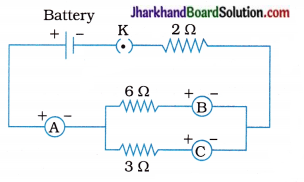
(a) Find the currents passing through ammeters A and C.
(b) Find the total resistance of the circuit.
Answer:
(a) current passing through ammeter C = 1 A, current passing through ammeter A= 1.5 A
(b) 4Q
11. If an electric bulb gives light for lhour while carrying 0.5A current, how much electric charge passes through it and how many electrons pass through it during this time? (e = 1.6 x 10-19C)
Answer:
Q = 1800 C,
n = 1.125 x 1022
12. An electric current of 64mA flows through a bulb for 10minutes. How many electrons pass through the bulb during this time?
(e = 1.6 x 10-19C)
Answer:
n = 2.4 x 1020
13. In order to get a current of 0.5A in a circuit by connecting a bulb of resistance 20 Ω with 12 V battery, what should be the resistance to be connected in series? What will be the voltage drop across the bulb?
Answer:
R = 4Ω, V = 10 V
14. Three resistors are connected in parallel with a 30V battery. A current of 7.5A flows through the circuit. If two out of the three resistors are of 10Ω and 12Ω, determine the resistance of the third resistor.
Answer:
15 Ω
15. For the circuit shown in the following figure, determine the equivalent resistance between points A and B. Also find the current I flowing through the circuit.
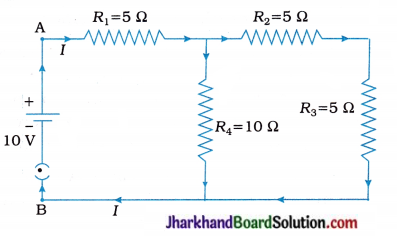
Answer:
10 Ω, 1 A
16. Determine the equivalent resistance between point A and B in the following circuit:
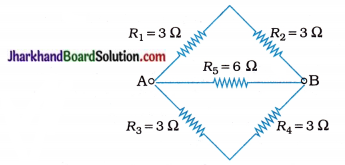
Answer:
2 Ω
17. In a house, if three bulbs of 100W, 60W and 40 W respectively are used 2 hours per day, how many units of electrical energy will be consumed in 30 days?
Answer:
12 units
18. Find the electric current in the following circuit:
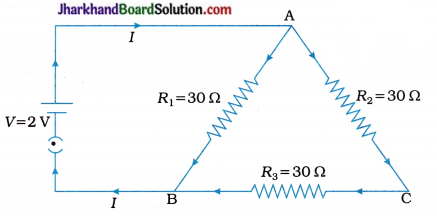
Answer:
0.1 A
19. Determine the equivalent resistance between points X and Y in the following circuit:
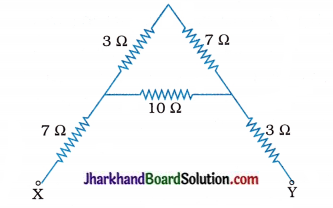
Answer:
15 Ω
20. An electric heater consumes 4.4 kW power when connected with a 220V line voltage.
(1) Calculate the current flowing in the heater.
(2) Calculate the resistance of the heater.
(3) Calculate the energy consumed in 2 hours.
Answer:
(1) 20 A
(2) 11 Ω
(3) 3.168 x 107 J
![]()
Question 2.
State at least three points of difference between the following terms / quantities:
(1) Resistance and Resistivity
Answer:
| Resistance | Resistivity |
| 1. Resistance is the ratio of the voltage applied between the two ends of a conductor to the electric current flowing through the conductor. (R = \(\frac { V }{ I }\)) |
1. Resistivity of a substance is the resistance offered by a conducting wire of unit length and unit cross-sectional area. (ρ = R. \(\frac { A }{ l }\)) |
| 2. It depends on the type of substance, physical conditions such as temperature and pressure and dimensions of the conductor (length and area of cross-section). | 2. It depends on the type of substance, temperature of the conductor and pressure exerted on the conductor. |
| 3. Its SI unit is Ω. | 3. Its SI unit is Ω m. |
(2) Series combination of resistors and Parallel combination of resistors
Answer:
| Series combination of resistors | Parallel combination of resistors |
| 1. In a series combination of resistors, the resistors are connected across two points in the circuit such that the current flowing through each resistor is the same and only one path is available for the current to flow. | 1. In a parallel combination of resistors, the resistors are connected across two points in the circuit such that the voltage drop across two ends of each resistor remains the same and more than one path are available for the current to flow. |
| 2. In this case, the total voltage drop is equal to the sum of the voltage drops across each resistor. | 2. In this case, the total current flowing through the circuit is equal to the sum of the currents flowing through each resistor. |
| 3. The equivalent resistance of a series combination of resistors is equal to the sum of the resistances of the individual resistors. | 3. The reciprocal of the equivalent resistance of a parallel combination of resistors is equal to the sum of the reciprocal of the resistances of the individual resistors. |
| 4. In this case, the equivalent resistance is greater than the largest of all the individual resistances. | 4. In this case, the equivalent resistance is smaller than the smallest of all the individual resistances. |
| 5. This combination is used in order to increase the resistance of the circuit. | 5. This combination is used in order to decrease the resistance of the circuit. |
| 6. In this case, the total current in the circuit decreases. | 6. In this case, the total current in the circuit increases. |
Question 3.
Give scientific reasons for the following statements:
(1) It is not advisable to connect an electric bulb and electric heater in series.
Answer:
An electric bulb and electric heater have different resistances and the requirement of current for their proper functioning is different.
Moreover, sometimes the devices may get damaged. If one of the devices stops and the circuit breaks, the other device cannot be used.
(2) For domestic purposes, different electrical devices are connected in parallel instead of connecting them in series.
Answer:
Each device gets the full and same voltage as that of the electric supply.
Also each device gets proper current depending on its resistance.
If one of the devices is switched OFF / ON, other electrical devices remain unaffected.
(3) Fairy decorative lights are always connected in parallel.
Answer:
If the fairy lights are connected in series, the equivalent resistance offered will be greater and the brightness of the bulbs will be affected. But in parallel connection all the bulbs will glow with same intensity and if any one bulb gets fused the other bulbs will continue to glow.
(4) In a tungsten electric-bulb, a coil of wire, rather than a straight wire, is used.
Answer:
A coil of wire has much greater surface area than a straight wire if enclosed in the same bulb. This results in more emission of light.
Hence, in a tungsten electric-bulb, a coil of wire, rather than a straight wire, is used.
Objective Questions and Answers
Question 1.
Answer the following questions in one word / sentence:
(1) Name the scientist in whose honour the SI unit of electric current is named.
Answer:
Andre Ampere
(2) Which type of electric force acts between the proton and the electron?
Answer:
Attractive electric force
(3) Write the relation between the joule, coulomb and the volt.
Answer:
1 volt = \(\frac { 1 joule }{ 1 coulomb }\)
(4) How is the device measuring electric current connected in the circuit?
Answer:
In series
(5) You are given aluminium wire and copper wire having the same dimensions. Which wire will carry more electric current if the applied potential difference is the same for the two wires?
Answer:
Copper wire
(6) Name one electric appliance working on the principle of heating effect of electric current.
Answer:
Electric iron
(7) If a resistive wire is uniformly stretched, what will be a change in its resistance?
Answer:
Its resistance will increase
(8) Name a physical quantity which can be expressed in Ws.
Answer:
Electric energy
(9) Name the particle responsible for flow of electric current in a metallic conductor.
Answer:
The electron
(10) Which instrument is used to measure electric potential difference ?
Answer:
Voltmeter
(11) Draw a symbol for variable resistor.
Answer:

(12) How much energy in joule is consumed when 100 units electricity are used?
Answer:
3.6 x 108 J
(13) Write the Ohm’s law in the form of a formula.
Answer:
V = IR
Where
V = Potential difference across the ends of metallic wire of resistance R at constant temperature
I = Current flowing through the metallic wire
![]()
Question 2.
Fill in the blanks:
- Electric charge on …………………… is taken negative.
- In a substance, the direction of conventional current is opposite to the direction of …………………… current.
- Electric component, …………………… has symbol

- The SI unit of electric potential is ……………………
- In a circuit, a voltmeter is always connected …………………… to the electrical component.
- When a battery is connected in a circuit, in the external circuit, electric current flows from the …………………… terminal to the ………………….. terminal of the battery.
- The SI unit of electric power is ……………………
- According to Joule’s law, heat energy produced in a resistor is directly proportional to the square of ……………………
- 1 unit (commercial unit of electric energy) = …………………… J
- The equivalent resistance between points X and Y in the circuit shown in the following figure is ……………………

- The rate of consumption of electric energy with time is called ……………………
- 1 A = …………………… µA.
Answer:
- the electron
- electron
- resistor
- the volt or the joule per coulomb
- in parallel
- positive, negative
- the watt
- the electric current flowing through the resistor
- 3.6 x 106
- 5 Ω
- electric power
- 106
Question 3.
State whether the following statements are true or false:
- The SI unit of electric current is the coulomb.
- To measure electric current, an ammeter is connected in series with a resistor.
- W = VQ.
- The current flowing through each resistor is the same when resistors having different! resistances are connected in parallel.
- The equivalent resistance (Rs) of a series combination of resistors is given by \(\frac{1}{R_{\mathrm{s}}}=\frac{1}{R_1}+\frac{1}{R_2}\) + ……………
- Nichrome wire is used to make resistors.
- When the temperature of a metallic substance increases up to a certain limit, its resistance decreases.
- For two wires of the same material and having the same length, the resistance of the thicker wire is less than that of the other wire.
- Electric charge is measured by using an ammeter.
- Work can be expressed in coulomb-volt.
- Two bulbs of 60 W, 220 V when connected in series with a supply voltage of 220 V, light up with maximum intensity.
Answer:
- False
- True
- True
- False
- False
- True
- False
- True
- False
- True
- False
Question 4.
Match the following :
(1)
| Column I | Column II | Column III |
| 1. Electric current | a. VI | p. The volt / ampere |
| 2. Electric potential difference | b. Q/t | q. The joule |
| 3. Resistance | c. W/Q | r. The coulomb / second |
| 4. Electric energy | d. V/I | s. The joule / second |
| 5. Electric power | e. V I t | t. The volt |
Answer:
(1 – b – r), (2 – c – t), (3 – d – p), (4 – e – q), (5 – a – s).
(2)
| Column I | Column II | Column III |
| 1. Copper | a. Insulator | p. It is used to make resistance. |
| 2. Nichrome | b. Semi-conductor | q. It stops electric current. |
| 3. Wood | c. Conductor | r. It is used to make conduc-ting wire. |
| 4. Silicon | d. Resistor | s. It is used to make elec-tronic components. |
Answer:
(1 – c – r), (2 – d – p), (3 – a – q ), (4 – b – s).
(3)
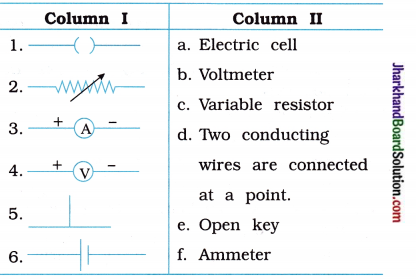
Answer:
(1 – e), (2 – c), (3 – f), (4 – b), (5 – d), (6 – a).
Question 5.
Choose the correct option from those given below each question:
1. The SI unit of electric charge is the ……………….
A. ampere
B. volt
C. watt
D. coulomb
Answer:
D. coulomb
2. How many electrons will be there in 1.6 C charge?
A. 1017
B. 1018
C. 1019
D. 1020
Answer:
C. 1019
3. 1 µA = …………………. mA
A. 10-16
B. 10-3
C. 1019
D. 1020
Hint IµA = 10-3 x 10-3A = 10-3 mA
Answer:
B. 10-3
4. Which of the following materials has more number of free electrons in a given volume?
A. Copper
B. Glass
C. Rubber
D. Iron
Answer:
A. Copper
5. According to Ohm’s law ………………….
A. the resistance increases with an increase in current.
B. the resistance increases with an increase in voltage.
C. the current increases with an increase in voltage.
D. both the resistance and current increase with an increase in voltage.
Answer:
C. the current increases with an increase in voltage.
6. The formula for electric current is
A. I = Qt
B. I = Y
C. I = \(\frac { Q }{ t }\)
D. I = W.t
Answer:
C. I = \(\frac { Q }{ t }\)
7. 2 A electric current is passed for 1 minute through a conducting wire. How much electric charge will pass through this wire?
A. 2C
B. 30 C
C. 60 C
D. 120 C
Answer:
D. 120 C
Hint : I = \(\frac { Q }{ t }\)
∴ Q = I x t = (2 A)(1 x 60s)
= 120 C
8. If 4.8 A current is passed through an electrical appliance, the number of electrons passing through it in 1 second will be ………………..
A. 0.33 x 1019
B. 3.3 x 1019
C. 3 x 1019
D. 4.8 x 1019
Answer:
C. 3 x 1019
Hint: I = \(\frac { Q }{ t }\) = \(\frac { ne }{ t }\)
∴ n = \(\frac { I × t }{ e }\)
= \(\frac{4.8 \times 1}{1.6 \times 10^{-19}}\)
= 3 x 1019
9. Which of the following formulae represents voltage?
A. \(\frac{\text { Work }}{\text { current } \times \text { time }}\)
B. \(\frac{\text { Work } \times \text { time }}{\text{ Current} }\)
C. Work x electric charge
D. Work x electric charge x time
Answer:
A. \(\frac{\text { Work }}{\text { current } \times \text { time }}\)
Hint: V = \(\frac { W }{ Q }\) = \(\frac { W }{ I.t }\)
10. The unit of electric potential difference is ………………..
A. J
B. J/C
C. JC
D. C/J
Answer:
B. J/C
11. If the work done to take 3C electric charge from one point to another point is 15 J, what will be the potential difference between these two points?
A. 3V
B. 15 V
C. 5V
D. 45 V
Answer:
C. 5V
Hint: Potential difference V = \(\frac { W }{ Q }\)
= \(\frac { W }{ Q }\)
![]()
12. The resistance of a conducting wire is 10 Ω. If a battery of 1.5 V is connected to it, the electric current flowing through it will be
A. 0.15 mA
B. 1.5 mA
C. 15 mA
D. 150 mA
Answer:
D. 150 mA
Hint:
R = \(\frac { V }{ I }\) = \(\frac { 1.5 }{ 10 }\) = 0.15
= 150 x 10-3
= 150 mA
13. On which factors does the resistivity of a conducting wire depend?
A. The length of the wire
B. The area of cross-section of the wire
C. The volume of the wire
D. The material of the wire
Answer:
D. The material of the wire
14. If five equal pieces of a resistance wire having 5 Ω resistance are connected in parallel, their equivalent resistance will be ……………………….
A. \(\frac { 1 }{ 5 }\) Ω
B. 1 Ω
C. 5 Ω
D. 25 Ω
Answer:
A. \(\frac { 1 }{ 5 }\) Ω
Hint: When a resistance wire having 5 Ω resistance is cut into five equal pieces, each piece will have resistance 1 Ω, i.e., R1 = R2 = R3 = R4 = R5 = 1 Ω.
The equivalent resistance (Rp) of their parallel combination is given by,
\(\frac{1}{R_{\mathrm{p}}}=\frac{1}{R_1}+\frac{1}{R_2}+\frac{1}{R_3}+\frac{1}{R_4}+\frac{1}{R_5}\)
∴ \(\frac{1}{R_{\mathrm{p}}}=\frac{1}{1}+\frac{1}{1}+\frac{1}{1}+\frac{1}{1}+\frac{1}{1}\)
∴ \(\frac{1}{R_{\mathrm{p}}}=\frac{5}{1}\)
∴ Rp = \(\frac { 1 }{ 5 }\) Ω
15. The SI unit of resistivity is …………………
A. Ω
B. Ω m
C. \(\frac { Ω }{ m }\)
D. \(\frac { m }{ Ω }\)
Answer:
B. Ω m
16. What will be the equivalent resistance between points A and B of the following electric circuit?
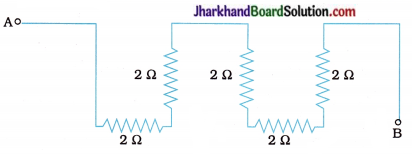
A. 1 Ω
B. 2 Ω
C. 5 Ω
D. 10 Ω
Answer:
D. 10 Ω
Hint: The given electric circuit can be drawn as follows:

As all resistors are connected in series, their equivalent resistance,
Rs = 2 + 2 + 2 + 2 + 2 = 10 Ω
17. The equivalent resistance between points A and B of the following electric circuit will be ………………..
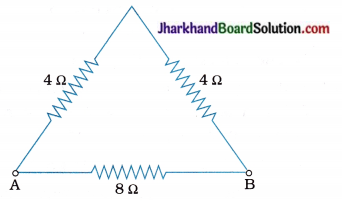
A. 4 Ω
B. 8 Ω
C. 2 Ω
D. 16 Ω
Answer:
A. 4 Ω
Hint: The given electric circuit can be drawn as follows:
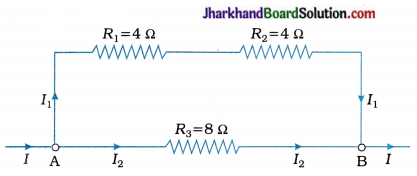
It is clear from the circuit that resistors R1 and R2 are connected in series.
∴ R’ = R1 + R2 = 4 + 4 = 8 Ω
Now, R’ is connected with R3 in parallel combination.
∴\(\frac{1}{R}=\frac{1}{R^{\prime}}+\frac{1}{R_3}\)
= \(\frac { 1 }{ 8 }\) + \(\frac { 1 }{ 8 }\)
= \(\frac { 2 }{ 8 }\) = \(\frac { 1 }{ 4 }\)
∴ R = 4 Ω
Question 18.
The equivalent resistance between points A and B in the following electric circuit is ……………..

A. 2.5 Ω
B. 5 Ω
C. 12.5 Ω
D. 20 Ω
Answer:
C. 12.5 Ω
Hint: Resistors R1 and R2 are connected in parallel.
∴ R’ = \(\frac{R_1 R_2}{R_1+R_2}=\frac{5 \times 5}{5+5}\) = 2.5 Ω
Now, R’, R3 and R5 are connected in series
∴R = R’ + R3 + R5
= 2.5 + 5 + 5 = 12.5 Ω
19. Which physical quantity is expressed in kWh?
A. Work
B. Electric power
C. Electric Current
D. Electric potential
Answer:
A. Work
20. 1 kWh = ………………. J
A. 3.6 x 106
B. 3.6 x 103
C. 3.6 x 10-6
D. 3.6 x 10-3
Answer:
A. 3.6 x 106
Hint : 1 kWh = (1000 W) (3600 s)
= 3.6 x 106 J
21. An electric heater consumes 1.1 kW power when 220 V voltage is applied to it. The current flowing through it must be ……………….
A. 1.1 A
B. 2.2 A
C. 4 A
D. 5 A
Answer:
D. 5 A
Hint: P = VI
∴ I = \(\frac{P}{V}=\frac{1.1 \times 10^3}{220}=\frac{1100}{220}\)
22. 1 A = ……………. mA
A. 100
B. 10³
C. 10-3
D. 10-6
Answer:
B. 10³
23. In an electric field, electric potential at a point is 10 V How much work has to be done to bring 0.5 C electric charge from infinite distance to that point?
A. 0.5 J
B. 2 J
C. 5 J
D. 10 J
Answer:
C. 5 J
Hint: W = VQ = (10) (0.5) = 5 J
24. ……………… is the work done in moving a unit positive charge from point A to B in an electric field.
A. Electric potential at point A.
B. Electric potential at point B.
C. Electric potential difference between points A and B.
D. Electric current from point A to point B.
Answer:
C. Electric potential difference between points A and B.
25. In an electric field, electric potential at point A is 40 V and that at point B is 90 V The work to be done in taking 2 C charge from point A to point B is ………………
A. 25 J
B. 50 J
C. 90J
D. 100 J
Answer:
D. 100 J
Hint: VB – VA = \(\frac { W }{ Q }\)
∴ W = Q (VB – VA)
= (2) (90 – 40) = 100 J
26. Sonika is working with the circuit shown in the following figure :
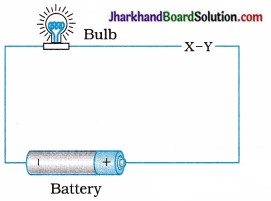
The circuit has two gaps : X and Y. She has wires of five different materials – I, II, III, IV and V She knows that the bulb will light up only when both gaps are filled with conducting materials.
She records her observations in a table. After completing the experiment, ink fell on the paper and she lost entries in row 3.
| No. | Material in X | Material in Y | Bulb (On/Off) |
| 1 | I | II | Off |
| 2 | I | IV | On |
| 3 | Off | ||
| 4 | III | V | On |
Based on the rest of the information in the table, out of the following what could be the materials in row 3?
A. II and III
B. III and IV
C. IV and V
D. I and III
Answer:
A. II and III
Hint: The entries in rows 2 and 4 show that
I : conducting material, IV : conducting material, III : conducting material, V : conducting material,
This information, combined with the entries in row 1, shows that
II : Non-conducting material Row 3 must include II.
27. ‘Ω m’ is the SI unit of ……………..
A. resistance
B. resistivity
C. conductivity
D. resistance per unit length
Answer:
B. resistivity
28. I – V graph for a resistance wire is shown in the figure given below:
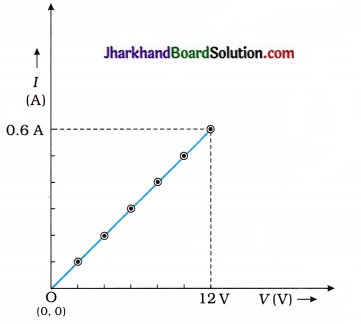
What will be resistance of this wire?
A. 50 Ω
B. 20 Ω
C. 7.2 Ω
D. \(\frac { 1 }{ 120 }\)Ω
Answer:
B. 20 Ω
Hint: The slope of I-V graph represents the reciprocal of resistance.
∴ Slope = \(\frac { 1 }{ R }\) = \(\frac { ∆I }{ ∆V }\)
∴R = \(\frac{\Delta V}{\Delta I}=\frac{12-0}{0.6-0}=\frac{12}{0.6}\) = 2.0 Ω
29. What will be the change in the resistivity of a resistance wire, when its length is doubled by stretching it uniformly?
A. Will be doubled
B. Will be half
C. Will be one-fourth
D. Will not change
Answer:
D. Will not change
30. Observe the circuit in the following figure and select the correct statement:

A. Resistors with resistances R1 and R2 are connected in series.
B. Resistors with resistances R1 and R2 are connected in parallel.
C. Resistors with resistances R2 and R3 are connected in series.
D. Resistors with resistances R2 and R3 are connected in parallel.
Answer:
D. Resistors with resistances R2 and R3 are connected in parallel.
31. Resistors with resistances 5 Ω, 10 Ω and 15 Ω are connected in parallel to each other. What will be the equivalent resistance of the circuit? A. Less than 5 Ω
B. More than 15 Ω
C. More than 30 Ω
D. Equal to 30 Ω
Answer:
A. Less than 5 Ω
![]()
32. The resistance of a wire is R. When this wire is stretched so that its length becomes double, its cross-sectional area becomes half. What will be the resistance of this stretched wire?
A. \(\frac { R }{ 2 }\)
B. R
C. 2R
D. 4R
Answer:
D. 4R
Hint: Original resistance of the wire R = ρ.\(\frac { 1 }{ A }\)
Resistance of the stretched wire R’ = ρ.\(\frac { l’ }{ A’ }\)
But l’ = 2l and A’ = \(\frac { A }{ 2 }\)
∴ R’ = ρ\(\frac{2 l}{\frac{A}{2}}\) = (4)ρ\(\frac { 1 }{ A }\) = 4R
33. When three resistors, each of resistance R, are connected in parallel, the equivalent resistance is found out to be 10 Ω. R must be …………..
A. 10 Ω
B. 20 Ω
C. 30 Ω
D. 5 Ω
Answer:
C. 30 Ω
Hint :
\(\frac{1}{R^{\prime}}=\frac{1}{R_1}+\frac{1}{R_2}+\frac{1}{R_3}\)
Now, R1 = R2 = R3 = R
∴ \(\frac{1}{R^{\prime}}=\frac{1}{R}+\frac{1}{R}+\frac{1}{R}=\frac{3}{R}\)
∴ R = 3R’ = 3 (10) = 30 Ω
34. In the following figure, what will be the equivalent resistance between points A and B?

A. 1 Ω
B. 2 Ω
C. 4 Ω
D. 8 Ω
Answer:
B. 2 Ω
Hint: Here, resistors with resistances R1 and R2 are in parallel.
∴ R’ = \(\frac{R_1 R_2}{R_1+R_2}=\frac{2 \times 2}{2+2}\) = 1 Ω
Also, resistors with resistances R3 and R4 are in parallel.
∴ R” = \(\frac{R_3 R_4}{R_3+R_4}=\frac{2 \times 2}{2+2}\) = 1 Ω
The equivalent resistance of the resulting series combination will be
R = R’ + R”
= 1 + 1 = 2 Ω
35. A wire having resistance 20 Ω is bent in the form of a circle as shown in the following figure :
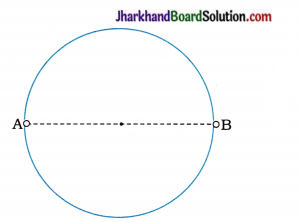
What will be the resistance between two end points A and B located on the diameter?
A. 5 Ω
B. 10 Ω
C. 20 Ω
D. 40 Ω
Answer:
A. 5 Ω
Hint: The resistance of the wire is R = 20 Ω. Hence, the resistance of the upper part of the circle = \(\frac { R }{ 2 }\) = 10 Ω
Similarly, the resistance of the lower part of the circle = \(\frac { R }{ 2 }\) = 10 Ω.

As shown in the figure above, resistors with resistances 10 Ω and 10 Ω are in parallel. So, the equivalent resistance of the combination will be R’ = \(\frac { (10)(10) }{ 10+10 }\) = 5 Ω
36. Which of the following options is not the formula for heat energy (in joule) produced when a current is passed through a conductor?
A. H = I²Rt
B. H = \(\frac { V²t }{ R }\)t
C. H = IVt
D. H = \(\frac { V² }{ I² }\)t
Answer:
D. H = \(\frac { V² }{ I² }\)t
37. Which option is correct for the following statements A and B?
Statement A : The current passing through each resistor is the same in a series combination of resistors.
Statement B : The voltage between two ends of each resistor is the same in a parallel combination of resistors.
A. Statement A is true but statement B is false.
B. Statement A is false but statement B is true.
C. Statement A and statement B both are true.
D. Statement A and statement B both are false.
Answer:
C. Statement A and statement B both are true.
38. In which of the following circuits the voltmeter and ammeter are connected properly to verify the Ohm’s law?
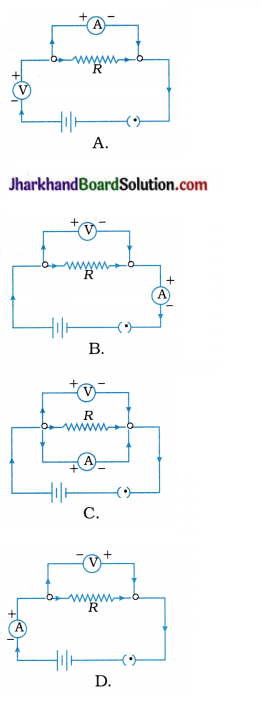
Answer:
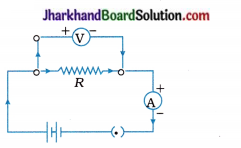
Hint: An ammeter should be connected in series to measure electric current and a voltmeter should be connected in parallel to the resistor to measure potential difference. While joining these two instruments their positive and negative terminals should be taken into consideration.
39. Maximum 1A current can pass through a bulb having resistance 100 Q. What will be the power of this bulb?
A. 10W
B. 100 W
C. 1000 W
D. 0.01 W
Answer:
B. 100 W
Hint: P = I²R = (1)²(100) = 100 W
40. Which of the following is not a unit of electric energy?
A. The watt-second
B. The kilowatt hour
C. The joule
D. The watt
Answer:
D. The watt
41. Of which physical quantity is the unit, ‘VA’?
A. Electric energy
B. Electric power
C. Heat energy
D. Electric potential
Answer:
B. Electric power
42. Which of the following circuit symbols is used to represent an electric cell?
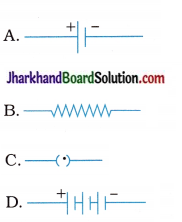
Answer:

43. The resistance of 300 m long wire with cross-sectional area 10-6m² and resistivity 10-7 Ω m is
A. 30 Ω
B. 3 Ω
C. 0.3 Ω
D. 300 Ω
Answer:
A. 30 Ω
Hint: R = ρ\(\frac { l }{ A }\)
= 10-7 x \(\frac{300}{10^{-6}}\)
= 30 Ω
44. What will be the equivalent resistance of the following circuit?
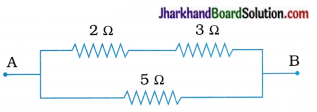
A. 10 Ω
B. 5 Ω
C. 2.5 Ω
D. 1 Ω
Answer:
C. 2.5 Ω
Hint: The resistance of the upper arm of the circuit is 2 + 3 = 5Ω.
Now, the upper arm and lower arm are connected in parallel to each other. So, the equivalent resistance of the circuit
R = \(\frac { 5×5 }{ 5+5 }\) = 2.5 Ω
45. Three resistors of resistances 2 Ω, 3 Ω and 5 Ω are connected in series with a 10 V battery.
The voltage across 2 Ω resistor will be
A. 10 V
B. 5V
C. 3V
D. 2V
Answer:
D. 2V
Hint: The equivalent resistance of the circuit R = 2 + 3 + 5= 10 Ω.
The current flowing through the circuit
I = \(\frac { V }{ R }\) = \(\frac { 10 }{ 10 }\) = 1 A
The voltage across 2 Ω resistor
= 2 x I = 2 Ω x 1 A = 2 V
46. An electric iron of power 2 kW is used for 3 hours. At ₹ 5 per unit, the electricity bill will be
A. ₹ 45
B. ₹ 30
C. ₹ 15
D. ₹ 10
Answer:
B. ₹ 30
Hint: Electric energy consumed in 3 hours W = P x t
= 2 kW x 3 h = 6 kWh = 6 unit
Cost of electric power consumed (electricity bill)
= 5 x 6 = ₹ 30
47. The working of electric fuse is based on the ……………
A. chemical effect of electric current.
B. heating effect of electric current.
C. voltage regulation in the circuit.
D. current regulation in the circuit.
Answer:
B. heating effect of electric current.
48. Resistivity of a material depends on …………………. of the material.
A. the length of the wire
B. the area of cross-section of the wire
C. the temperature
D. the volume of the wire
Answer:
C. the temperature
49. When resistors of resistances R1 and R2 (R2 < R1) are connected in parallel and the currents flowing through them are I1 and I2 respectively, then
A. I1 = I2
B. I1 > I2
C. I1 < I2
D. nothing can be said about the currents
Answer:
C. I1 < I2
50. When resistors of resistances R1 and R2 (R2 > R1) are connected in series and the currents flowing through them are I1 and I2 respectively, then
A. I1 = I2
B. I1 > I2
C. I1 < I2
D. nothing can be said about the currents
Answer:
A. I1 = I2
51. In the following circuit, which electric component is connected in a wrong manner?
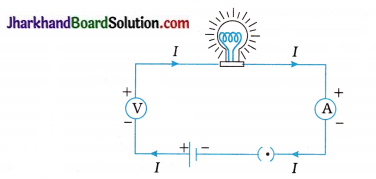
A. Voltmeter
B. Ammeter
C. Plug key
D. Cell
Answer:
A. Voltmeter
52. 1 C = ……………. µC
A. 10-6
B. 10-3
C. 1
D. 106
Answer:
D. 106
53. Connection of two cells of 1.5 V is shown in the following figure :

What is the voltage between the points A and B?
A. 1.5 V
B. 3 V
C. 0.75 V
D. 0 V
Answer:
B. 3 V
54. The following figure shows the V-I graph for four different resistors :
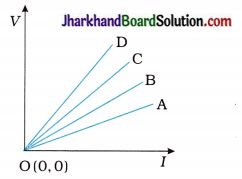
Which resistor has the maximum resistance?
A. A
B. B
C. C
D. D
Answer:
D. D
55. A potential difference of 100 V is applied across an electric bulb marked 40 W, 200 V. The power consumed in the bulb is …………………
A. 100 W
B. 40 W
C. 20 W
D. 10W
Answer:
D. 10W
Hint: P = \(\frac{V^2}{R}\)
∴ Resistance of the filament of the bulb,
R = \(\frac{V^2}{P}=\frac{(200)^2}{40}\) = 1000 Ω
Now, power consumed in the bulb,
P = \(\frac{V^2}{R}=\frac{(100)^2}{1000}\) = 10 W
Question 6.
Answer the following questions as directed (Miscellaneous):
(1) The voltage – current (V – I) graphs for a metallic conductor at two different temperatures T1 and T2 are shown below:

At which temperature is the resistance higher?
Answer:
At temperature T1.
Because, the slope \(\left(\frac{\Delta V}{\Delta I}\right)\) of the graph i.e., its resistance is greater at T1.
(2) A wire of given length is doubled on itself and this process is repeated once again. By what factor does the resistance of the wire change?
Answer:
As the length of the wire become y- of the original length its area of cross-section become 4 times.
So, new resistance
R’ = ρ\(\frac { l’}{ A’}\) = ρ\(\frac{(1 / 4)}{4 A}=\frac{1}{4 \times 4}\left(\rho \frac{l}{A}\right)\) = \(\frac { R}{ 16}\) (∵ R = ρ\(\frac { l}{ A’}\))
Thus, the new resistance is \(\frac { R}{ 16}\) of the original resistance.
(3) Through which of the following two wires, does the electric current flow more easily?
(a) A thick wire
(b) a thin wire of the same material and of the same length when connected to the same source. State the reason.
Answer:
The thick wire because its resistance would be less compared to that of the thin wire.
(4) 400 J of heat is produced in 4 s in a 4 Q resistor. Find the potential difference across the resistor.
Answer:
Here, H = 400 J
∴ \(\frac { V²t }{ R }\) = 400
∴ V² = 400 x \(\frac { R }{ t }\) = 400 x \(\frac { 4 }{ 4 }\) = 400
∴ V = 20 volts
(5) What is the commercial unit of electrical energy?
Answer:
The kilowatt hour, i.e., kWh
(6) On what principle is an electric bulb based?
Answer:
Heating effect of current
(7) In a circuit, two resistors of resistances 5 Ω and 10 Ω are connected in series. Compare the current passing through the two resistors.
Answer:
In a series combination of resistors, the same current passes through all the resistors and it is same as the total current of the circuit.
Hence, here current will be the same in two resistors.
So, the ratio of the current will be 1:1.
(8) Write the relation between resistance R of the filament of a bulb, its power and a constant S voltage V applied across it.
Answer:
R = \(\frac { V² }{ P }\)
(9) Which of the following bulbs has more resistance?
(a) A 220 V, 100 W bulb
(b) a 220 V 60 W bulb.
Answer:
60 W bulb
Here, R \(\frac { 1 }{ p }\) (∵ as both the bulbs have the j same voltage rating.)
![]()
(10) Find the minimum resistance that can be made using five resistors, each of 5 Ω.
Answer:
By connecting given resistors in parallel, resistance 1 Ω is obtained which is the minimum.
Rp = \(\frac { R }{ n }\) = \(\frac { 5 Ω }{ 5 }\) = 1 Ω
(11) How does the resistance (R) of a wire depend upon its radius (r)?
Answer:
As R ∝ \(\frac{1}{A} \propto \frac{1}{\pi r^2}\) (∵A = πr²)
∴ R ∝ \(\frac { 1 }{ r² }\) (∵π = constant)
(12) An ammeter has a range (0 – 3A) and there are 30 divisions on its scale. Calculate the least count of the ammeter.
Answer:
Here, range of ammeter = 3 ampere
(i.e., The maximum current that can be measured by the given ammeter is 3A.)
No. of divisions on scale of ammeter = 30
The least count of the ammeter
= \(\frac{\text { Range of the ammeter }}{\text { Total no. of divisions }}\)
= \(\frac { 3 A }{ 30 }\)
= 0.1 A
(i.e., Minimum current that can be accurately measured by a given ammeter is 0.1 A.)
(13) In a voltmeter there are 20 divisions between 0 mark and 0.5 V mark. Calculate the least count of the voltmeter.
Answer:
Range of voltmeter = 0.5 V
No. of divisions = 20
∴The least count of the voltmeter
= \(\frac{\text { Range }}{\text { Total no. of divisions }}\)
= \(\frac { 0.5 V }{ 20 }\)
= 0.025 V
(14) To verify the Ohm’s law a circuit diagram was drawn by a student as shown below:
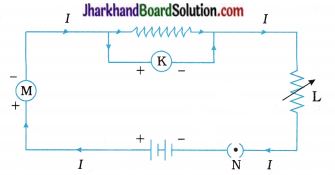
What do K, L, M, N stand for?
Answer:
K = voltmeter, L = rheostat, M = ammeter and N = plug key
(15) Four students connect 4 cells of 1.5 V each to get a battery of voltage 6 V. State the incorrect connection / connections. Justify your answer.
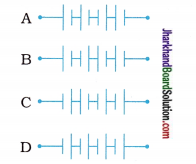
Answer:
A, B and C are incorrect connections (D is correct).
Because for a proper series connection of four cells, each of 1.5 V to obtain a battery of 6 V, the negative terminal of each cell should be connected to the positive terminal of the next cell or the positive terminal of each cell should be connected to the negative terminal of the next cell (connection D).
(16) Which of the following statements is correct?
(a) one volt is one joule per ampere.
(b) one volt is one joule per coulomb.
Answer:
(b) one volt is one joule per coulomb.
(17) Keeping the resistance constant, the potential difference applied across the ends of a component is halved. How does the current change?
Answer:
The current becomes half the initial current.
(18) Keeping the potential difference constant, the resistance of a circuit is halved. How does the current change?
Answer:
The current becomes double the initial S current.
(19) A potential difference of 10 V is needed i to make a current of 0.02 A flow through a wire. What potential difference is needed to make a current of 250 mA to flow through the same wire?
Answer:
According to the Ohm’s law,
R = \(\frac { V }{ I }\)
So, R = \(\frac { 10 }{ 0.02 }\)
= 500 Ω
Now, to make a current of
250 mA = 250 x 10-3A to flow through the ; same wire, the required potential difference is
V = IR = 250 x 10-3 x 500 = 125 V
(20) A current of 250 mA flows through a 4 kΩ resistor. What is the potential difference across the resistor?
Answer:
The potential difference across the resistor
V = IR
= 200 x 10-3 x 4 x 10³ = 800 V
(21) The electrical resistivities of four materials ; A, B, C and D are given below:
A : 110 x 10-8 Ω m
B : 1.0 x 1010 Ω m
C : 10.0 x 10-8 Ω m
D : 2.3 x 103 Ω m
Which material is a (a) good conductor (b) resistor (c) insulator (d) semi-conductor?
Answer:
(a) C
(b) A
(c) B
(d) D
(22) The equivalent resistance of a series combination of two resistors is 9 Ω and the equivalent resistance of a parallel combination of the same two resistors is 2Ω. Find the resistances of the resistors.
Answer:
Suppose two unknown resistances are x and y.
When the resistors are connected in parallel \(\frac { xy }{ x+y }\) = 2Ω and when they are connected in series x + y = 9 Ω.
So, \(\frac { xy }{ 9 }\) = 2 ∴ xy = 18 Ω
Now,
From x + y = 9, y = 9 – x
∴ x(9 – x) = 18
∴ 9x – x² = 18
∴ x² – 9x + 18 = 0
∴ x² – 6x – 3x + 18 = 0
∴ x (x – 6) – 3 (x – 6) = 0
∴ (x – 3) (x – 6) = 0
∴ x = 3 Ω or x = 6 Ω
Hence y = 9 – x = 9 – 3 = 6 Ω or y = 9 – 6 = 3 Ω
Thus, x = 3 Ω and y = 6 Ω or x = 6Ω and y = 3 Ω.
(23) An electric lamp is labelled 12 V, 36 W. This indicate that it should be used with a 12 V supply. What other information does the label provide?
Answer:
The electric lamp consumes electric energy at the rate of 36 J/s.
(24) Name two devices whose working is based on the heating effect of electric current.
Answer:
An electric iron, electric toaster
(25) Name the gases which are filled into the filament-type electric light bulbs.
Answer:
Argon, nitrogen
(26) Why are the filament-type electric light bulbs not power efficient?
Answer:
When electric power is supplied to the filament-type electric light bulb, most of the electric power consumed by the filament appears as heat (due to which the bulb becomes hot), only a small amount of electric power is converted into light. So, the filament-type electric light bulbs are not power efficient.
[Note : Tube-lights are much more power efficient because they have no filaments.]
(27) Under what conditions is the Ohm’s law applicable?
Answer:
The Ohm’s law is applicable when the physical conditions like temperature, pressure, etc. of a conductor do not change when a potential difference is applied across it.
(28) Why is Nichrome used as a heating element?
Answer:
Nichrome (alloy) has high resistivity and high melting point. Moreover, it does not react with air when it is red-hot (800 °C).
(29) Why are Constantan and Manganin used for making standard resistors?
Answer:
The resistivity of Constantan and Manganin is moderate and almost independent of temperature.
Hence, these materials are used for making standard resistors.
(30) Why is lead-tin alloy used for making a fuse?
Answer:
Lead-tin alloy has low melting point. Hence it is used for making a fuse.
(31) What is the difference between a resistor and resistance?
Answer:
A resistor is a component whereas resistance is its property due to which it opposes the flow of electrons through it.
![]()
(32) What do you mean by the term load in an electric circuit?
Answer:
Electric lamps, heaters, air conditioners, motors and other devices which work on electricity are called loads because they consume electric energy.
(33) How does the current divide itself in a parallel combination of resistors?
Answer:
In a parallel combination of resistors, the current divides in the inverse ratio of the resistances.
(34) How does the potential difference divide itself in a series combination of resistors?
Answer:
In a series combination of resistors, the potential difference across any of the resistors is directly proportional to its resistance.
(35) How is heat produced in a conductor by an electric current?
Answer:
Heat produced in a conductor by an electric current is due to collisions of free electrons with the ions and atoms in the conductor.
(36) If a number of bulbs of different wattages? are joined in parallel with a voltage source, which s bulb will glow with maximum brightness?
Answer:
The bulb with highest wattage (here, s lowest resistance) will glow with maximum brightness as P = \(\frac { V² }{ R }\) and here P ∝ \(\frac { 1 }{ R }\).
(37) Which bulb will glow with maximum brightness in case bulbs of different wattages are : joined in series with a voltage source?
Answer:
The bulb with highest wattage (here S highest resistance) will glow with maximum brightness as P = I²R and here P ∝ R.
(38) What can you say about the resistance s of an ammeter?
Answer:
The resistance of an ammeter should s be very low, ideally zero.
(39) What can you say about the resistance ; of a voltmeter?
Answer:
The resistance of a voltmeter should be very high, ideally infinite.
(40) How does the resistance of a metallic wire depend on its temperature?
Answer:
The resistance of a metallic wire increases with temperature.
(41) Two wires have the same length, same s radius but one of them is made of copper and l the other is made of iron. Which will have more resistance?
Answer:
As resistance R = ρ\(\frac { 1 }{ A }\) and resistivity ρ for iron is more than that for copper, the iron wire will have more resistance.
(42) Name a substance whose resistance decreases with temperature.
Answer:
Germanium (a semi-conductor)
(43) Name a substance whose resistance almost? remains unchanged with a change in temperature.
Answer:
Manganin (an alloy of Cu, Mn and Ni)
(44) Distinguish between the kilowatt and the kilowatt hour.
Answer:
The kilowatt (kW) is a unit of power and the kilowatt hour (kWh) is a unit of electric energy. .
1 kWh = 1 kW x 1 h
(45) Name two characteristics of a heater coil.
Answer:
A heater coil should have (i) high resistivity and (ii) high melting point.
(46) The power-voltage rating of an electric appliance is 100W-250V What does it signify?
Answer:
The electric appliance consumes a power of 100 W (i.e., an electric energy of 100 J per second) when connected to a 250 V electric supply.
(47) Why is much less heat generated in long electric cables than in the filament of an electric bulb?
Answer:
Electric cables are made of thick copper i.e., their area of cross-section is large, hence they have much less resistance as compared to the thin tungsten filament of an electric bulb.
(48) How much energy is consumed by 2 kW AC when used for 2 hour?
Answer:
Electric energy E = P x t
= 2 kW x 2 hour = 4 kWh
Where, 1 kWh = 3.6 x 106 J
(49) A wire of resistivity p is pulled to double its length. What will be its new resistivity?
Answer:
Resistivity of wire remains the same as resistivity p depends on the nature of material and temperature.
(50) How does the resistance of an ohmic < conductor depend on the applied voltage?
Answer:
Resistance R is a constant, so it does not depend upon the applied voltage.
(51) What causes the potential difference between the two terminals of a cell?
Answer:
Chemical reactions taking place within a cell result in excess of electrons at the one terminal and deficiency of electrons at the other terminal.
(52) Name and define the smallest commercial unit of electricity.
Answer:
The smallest commercial unit of electricity is the watt-hour (Wh).
It is defined as the amount of electric energy consumed by an electrical device of power rating 1 W in one hour.
(53) If the current I through a resistor is increased by 100 % (assume that the temperature of the resistor remains unchanged), find the percentage increase in power dissipated.
Answer:
Power dissipated P = I²R
Current after increased by 100% = I’
= I + \(\frac { 100 I }{ 100 }\)
= 2 I
So, new power P’ = I’²R = (2I)²R = 4I²R
∴ Percentage increase in power dissipation
= \(\frac{P^{\prime}-P}{P}\) x 100 %
= \(\frac{4 I^2 R-I^2 R}{I^2 R}\) x 100 %
= \(\frac{I^2 R(4-1)}{I^2 R}\) x 100 %
= 3 x 100%
= 300 %
Value Based Questions With Answers
Question 1.
Medha observed that the tubelights in the corridor of her school were always switched on the whole day. She brought the matter to the notice of her class teacher who talked to the Principal about it. The Principal took immediate action.
- Medha helped this way to reduce air pollution. Explain how.
- What values do you learn from Medha in this episode?
- What steps can the school take to get electricity consumption reduced?
Answer:
- Power / Electricity production involves burning of fossil fuel. Electricity saved is fuel saved, less fuel burnt means less air pollution.
- Courage, appreciation and protection of environment.
- (i) Students should switch off the lights while going out of their class, (ii) they should not waste water as it also involves the use of electricity many a times.
Question 2.
Shalini is a student of class X. Her mother was preparing tea in an old electric kettle having metal case. When she switched on the electric kettle, she got a severe electric shock. Shalini put off the main switch quickly and found that the connecting cord was torn, where her mother touched the metal case of the kettle. She also found that the red and black wires of the connecting cord were firmly connected to the two lower terminals of the power plug but S the green wire of the cord was not connected to the upper terminal of the plug.
Shalini replaced the torn connecting cord and also connected the three wires of the cord firmly to the power plug terminals.
On the basis of the above passage, answer the following questions :
- Why did Shalini switch off the main switch quickly?
- Which wire red, black or green, touched the metal case of electric kettle when Shalini’s s mother got electric shock?
- What values are displayed by Shalini in this incident?
Answer:
- Shalini switched off the main switch to cut-off the electricity supply to the faulty s’ kettle in order to save her mother.
- Red wire which is at high potential of 220 V was touching the metal case of electric kettle.
- The values displayed by Shalini are :
-
- Presence of mind.
- Concern for her mother.
- Knowledge of household wiring and daily life activities.
-
Question 3.
Bharat was doing an experiment by using an ammeter. Suddenly, it fell from his hand and broke. He was afraid, that he might be scolded and threaten by his teacher. His classmate advised him not to tell the teacher, but he refused and told his teacher. On listening to him patiently, the teacher did not scold him and threaten as it was just an accident and used the opportunity to show the internal structure of the ammeter to the whole class.
On the basis of above passage, answer the following questions :
- What values do you learn from Bharat?
- What is the use of ammeter? How is it connected in the circuit?
- State the aim of any one experiment, where Bharat could have used the ammeter.
Answer:
- The values learnt from Bharat are honesty, confidence and courage.
- An ammeter is used to measure the electric current flowing in a circuit. It is always connected in series in a circuit.
- Bharat could have used the ammeter to verify the Ohm’s law.
Question 4.
Mitali’s mother was cooking in the kitchen for guests. Mitali saw her mother had plugged in microwave, hot plate and food processor on the same plug point. She immediately switched off the plug and removed all the plugs and re-plugged them in separate individual plugs.
- What happens when we use too many electrical devices plugged in one power point?
- What is the power of a device?
- What value did Mitali display in the above act?
Answer:
- Plugging too many devices in one power point causes overloading which can lead to electrical fire.
- The power of an electrical device is the amount of electric energy used by it per unit time.
- Mitali showed the values of awareness and responsibility.
Question 5.
Vishva noticed in a dhaba around 50 bulbs, each of 100 W all were glowing. She calculated the cost of electricity consumed in one hour and told the dhaba owner to reduce the expenses and at the same time save electricity by using CFL bulbs instead of ordinary filament-type bulbs.
(1) What would be the cost of electric energy if 50 bulbs, each of 100 W, are used for one hour? 1 unit costs ₹ 5.
(2) What is a CFL?
(3) What value did Vishva display in the above case?
Answer:
(1) The cost of electricity consumed when 50 bulbs are used for 1 hour
= (number of units consumed) x ₹ 5 per unit
= (50 x \(\frac { 100 }{ 1000 }\) kWh x 1 h) x \(\frac { ₹ 5 }{ 1 unit }\)
= (5 k Wh) x \(\frac { ₹ 5 }{ 1 unit }\)
= ₹ 25
(2) A CFL is a compact fluorescent lamp.
(3) Vishva displayed responsible behaviour, awareness as a citizen, critical thinking and analysis.
Practical Skill Based Questions With Answers
Question 1.
The scales of an ammeter and a voltmeter are shown below:
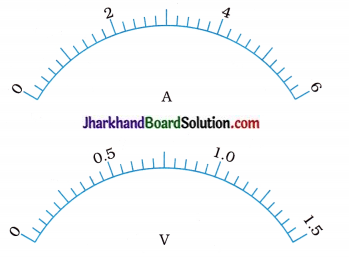
(1) What is the range of the ammeter and the range of the voltmeter?
(2) Find the least count of the ammeter and the voltmeter.
Answer:
(1) The range of the ammeter is 6 A and the range of the voltmeter is 1.5 V.
(2) The least count of the ammeter
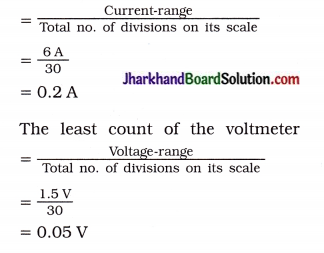
Question 2.
See the figure given below and find the readings of ideal ammeter and ideal voltmeter. (There is no zero error.)
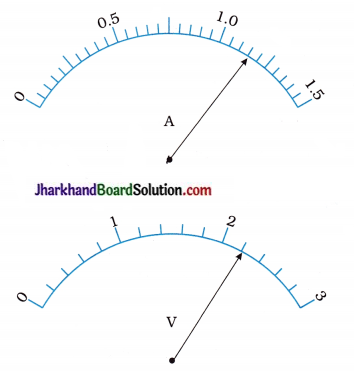
Answer:
The reading of the ammeter = 1.15 A. The value of 1 division on the scale of the ammeter (the least count) is \(\frac { 1.5 }{ 30 }\) = 0.05 A and its pointer shows 23 divisions on its scale. Hence, the ammeter reading = 23 x 0.05 A = 1.15 A.
The reading of the voltmeter = 2.2 V
The value of 1 division on the scale of the voltmeter (the least count) is \(\frac { 3 }{ 15 }\) = 0.2 V and its pointer shows 11 divisions on its scale. Hence the voltmeter reading 11 x 0.2 = 2.2V
Question 3.
In a given ammeter, a student observes that the needle indicates 17 divisions in the ammeter when performing an experiment to verify Ohm’s law. If the ammeter has 10 divisions between 0 and 0.5 A, then what is the value of 17 divisions?
Answer:
Since the ammeter has 10 divisions between 0 and 0.5 A, its least count or Vale of 1 division = \(\frac { 0.5A}{ 10 }\) = 0.5 A
Therefore, the value of 17 divisions
= 17 (0.05 A) = 0.85 A
![]()
Question 4.
Four resistors, each of 10 Ω, are connected to form a square as shown in the given figure. Find the equivalent resistance between the opposite corner A and C and between two points on any one side (AB).
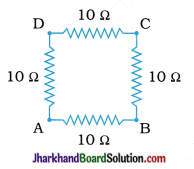
Answer:
(i) Resistance in the path
ADC = 10 Ω + 10 Ω = 20 Ω
Resistance in the path
ABC = 10 Ω + 10 Ω = 20 Ω
Now, \(\frac{1}{R_{\mathrm{AC}}}=\frac{1}{20}+\frac{1}{20}=\frac{1}{10}\)
∴Equivalent resistance,
RAC = 10 Ω
(ii) Resistance in the path ADCB
= 10 Ω + 10 Ω + 10 Ω = 30 Ω.
The resistance of 30 Ω is in parallel with AB (= 10 Ω).
Now, \(\frac{1}{R_{\mathrm{AB}}}=\frac{1}{30}+\frac{1}{10}\)
= \(\frac{1+3}{30}=\frac{4}{30}\)
∴ Equivalent resistance,
RAB = \(\frac { 30 }{ 4 }\) = 7.5 Ω
Question 5.
In the circuit shown in figure given below and find the current recorded by the ammeter (A).
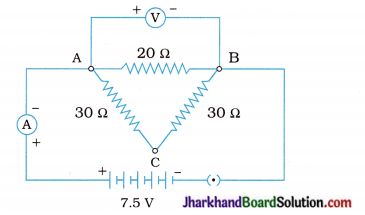
Answer:
Since resistance, AC = 30 Ω and resistances CB = 30 Ω. resistance in the path ACB = 30 Ω + 30 Ω = 60 Ω.
Further, 60 Ω (in the path ACB) and 20 Ω (in the path AB) are in parallel.
Hence, effective resistance (R) between A and B is given by
\(\frac{1}{R}=\frac{1}{60}+\frac{1}{20}=\frac{1+3}{60}=\frac{4}{60}=\frac{1}{15}\)
∴ R = 15 Ω
∴Current I = \(\frac { 7.5V }{ 15Ω }\) = 0.5 A
This is the current recorded by the ammeter.
Question 6.
Read the following information:
(1) The resistivity of copper is lower than that of aluminium which in turn is lower than that of constantan.
(2) Six wires labelled as A, B, C, D, E and F have been designed as per the following parameters :
| Wire | Length | Diameter | Material | Resistance |
| A | l | 2d | Aluminium | RA |
| B | 2l | d/2 | Constantan | RB |
| C | 3l | d/2 | Constantan | Rc |
| D | l/2 | 3d | Copper | RD |
| E | 2l | 2d | Aluminium | RE |
| F | l/2 | 4 d | Copper | RF |
Answer the following questions using the above data :
(1) Which of the wires has maximum resistance and why?
(2) Which of the wires has minimum resistance and why?
(3) Arrange RA, RB and RC in ascending order of their values. Justify your answer.
Answer:
(1) The wire C has maximum resistance because it has maximum length, least thickness and highest resistivity.
(2) The wire F has the minimum resistance, since it has least length, maximum thickness and least resistivity. (Using, R = ρ\(\frac { l }{ A }\))
(3) RC > RE > RA
(Using relation, R = ρ\(\frac { l }{ A }\) and comparision)
Question 7.
n resistors, each of resistance R are first connected in series and then in parallel. What is the ratio of the total effective resistance of the circuit in the series to the parallel combination?
Answer:
In the series combination, Rs = nR
In the parallel combination, Rp = \(\frac { R }{ n }\)
∴ \(\frac{R_{\mathrm{s}}}{R_{\mathrm{p}}}=\frac{n R}{R / n}\) = n²
Question 8.
Find out the readings of ammeter and voltmeter in the circuit given below:

Answer:
Equivalent resistance R = (2 + 3 + 3 + 4)Ω
= 12 Ω
Total current drawn = Ammeter reading
= \(\frac { V }{ R }\)
= \(\frac { 6 }{ 12 }\) = 0.5 A
Voltmeter reading = IR1 = 0.5 x 2 = 1 V
Question 9.
In the given circuit diagram, calculate :
(1) the value of current through each resistor
(2) the total current in the circuit
(3) the total effective resistance of the circuit.
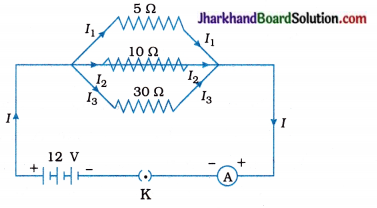
Answer:

Question 10.
Show four different ways in which three resistors of Y ohm, each may be connected in a circuit. In which case is the equivalent resistance of the combination :
(1) Maximum?
(2) Minimum?
Answer:
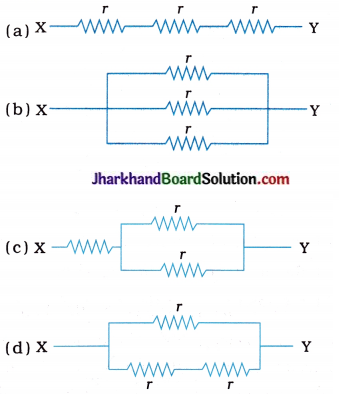
(1) Circuit (a) has maximum resistance
(2) Circuit (b) has minimum resistance
Question 11.
Find the current drawn from the battery by the network of four resistors shown in the figure.

Answer:
Two combinations of 3V two parallel resistors of 10 Ω each are connected in series.
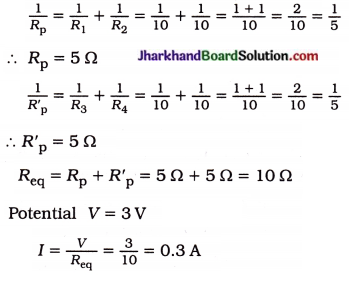
Question 12.
Find the equivalent resistance across the ends A and B of this circuit.
Answer:
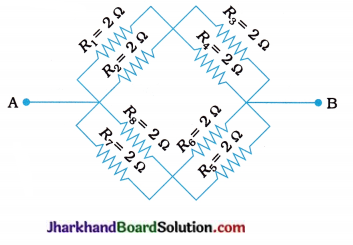
\(\frac{1}{R_{1,2}}=\frac{1}{R_1}+\frac{1}{R_2}=\frac{1}{2}+\frac{1}{2}=\frac{2}{2}\) = 1
∴ R1,2 = 1 Ω
Similarly R3,4 = 1 Ω
R5,6 = 1 Ω
R7,8 = 1 Ω
Now R1,2 and R3,4 are connected in series
R1,2,3,4 = R1,2 + R3,4 = 1 + 1 = 2Ω
Also, R5,6 and R7,8 are connected in series
R5,6,7,8 = R5,6 + R7,8 = 1 + 1 = 2Ω
Now, equivalent resistance
\(\frac{1}{R_{\mathrm{eq}}}=\frac{1}{R_{1,2,3,4}}+\frac{1}{R_{5,6,7,8}}\)
= \(\frac{1}{2}+\frac{1}{2}=\frac{2}{2}\) = 1
∴ Req = 1 Ω
Question 13.
Five resistors are connected in a circuit as shown. Find the ammeter reading when the circuit is closed.
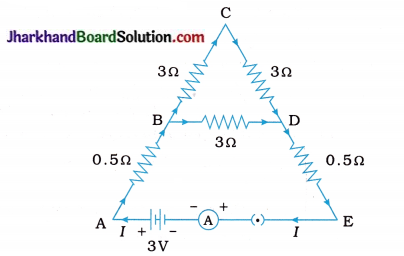
Answer:
Let the resistance between the points B and D be x.
∴ x = \(\frac{3 \Omega \times 6 \Omega}{3 \Omega+6 \Omega}\)
Now, the resistance of the entire circuit is
R = 0.5 Ω + x + 0.5 Ω
= 0.5 Ω + 2.0 Ω + 0.5 Ω
= 3.0 Ω
∴ Ammeter reading = \(\frac { 3 V }{ 3 Ω }\) = 1.0 A.
Question 14.
Draw a diagram of an electric circuit containing a cell, a key, an ammeter, a resistor of 2 Ω in series with a combination of two resistors (4 Ω each) in parallel and a voltmeter across the parallel combination.
Will the potential difference across the 2 Ω resistor be the same as that across the parallel combination of 4 Ω resistors? Give the reason.
Answer:
If Rp is the effective resistance of two resistors of 4 Ω each in parallel, then
\(\frac{1}{R_{\mathrm{p}}}=\frac{1}{4}+\frac{1}{4}=\frac{2}{4}=\frac{1}{2}\)
∴ Rp = 2 Ω
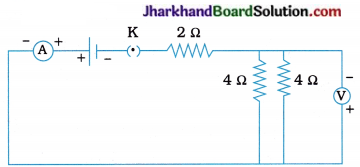
Since, the combined parallel resistance is also 2 Ω, the potential difference across 2 Ω resistor will be the same as that across the parallel combination of two 4 Ω resistors.
Question 15.
A current of 1A flows in a series circuit containing an electric lamp and a conductor of 5 Ω connected to a 10 V battery. Calculate the resistance of the electric lamp.
Now if a resistance 10 Ω is connected in parallel with this series combination, what change (if any) in current flowing through 5 Ω conductor and potential difference across the lamp will take place Give the reason.
Answer:
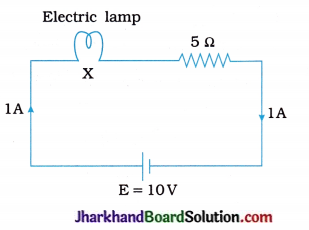
As, I = \(\frac{E}{R_1+R_2}\)
1 = \(\frac { 10 }{ x+5 }\)
or
∴ x = 5 Ω is the resistance of the lamp.
When a resistor of resistance 10 Ω is connected in parallel with x + 5 = 10 Ω, the total resistance Rp of the arrangement is given by,
\(\frac { 10 }{ x+5 }\)
= \(\frac { 1 }{ 5 }\)
∴ Rp = 5 Ω
∴ The current in circuit = \(\frac{E}{R_{\mathrm{p}}}\)
= \(\frac { 10 }{ 5 }\)
= 2 A
This current (2 A) divides eΩually between 10 Ω and (resistance of lamp + 5 Ω).
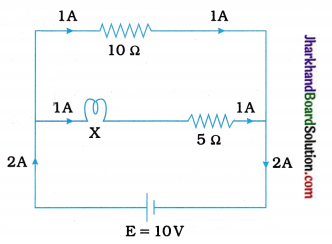
∴ The current through the lamp will be again 1 A, i.e., it remains the same.
The potential difference across the lamp will be 1 × x = 1 x 5 = 5V.
Therefore, the potential difference across the lamp will remain the same.
Memory Map:
